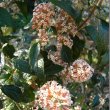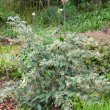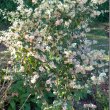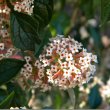| Botanical Name |
|
| Family |
Buddlejaceae - The buddleja family. |
| Pronunciation |
BUD-lee-uh aw-rik-yoo-LAY-tuh |
| Common Name(s) |
|
| Plant Group |
- Shrub A woody plant of relatively low height, having several stems arising from the base and lacking a single trunk; a bush.
|
| Plant Size |
- Large
| Tree | 18m to 25m |
| Shrub | 3m to 4m |
| Perennial/ground cover | 75cm to 1m |
| Bulb | 80cm to 1.2m |
| Succulent | 1m to 1.5m |
|
| Position |
- Partial Shade The area is in shade for part of the day and in full sun for part of the day.
- Sun The area is in full sun for all or most of the day, all year round.
|
| General Information |
- Drought Tolerance: Moderate The plant is moderately adapted to arid conditions and can survive short periods of drought and high temperatures without extra water.
- Evergreen Plants that have leaves all year round.
- Fragrant / Aromatic These plants posses a strong, usually pleasant odour.
- Frost: Hardy The plant can withstand freezing temperatures or frost without artificial protection.
- Roots Non-invasive Safe to plant near pools, paving, walls or buildings.
- Water Wise Plant species originating from low rainfall regions that require less water to survive and thrive than other plant species.
- Wind Tolerant Plants able to withstand the effect of strong winds.
|
| Specific Information |
With glossy, dark green and silvery foliage throughout the year, fragrant flowers in winter and frost hardy to boot, Buddleja auriculata is a must for any medium to large garden within its habitat range. This dense shrub or small tree branches from low down and has a graceful, weeping form. It should get sun for most of the day. Buddleja auriculata can survive temperatures ranging from about -5°C to 38°C.
|
| Ad Break |
|
| Flowers |
| Description |
small, tubular, with orange center, in heavy sprays at the ends of the arching branches
|
| Season |
- Autumn to Winter Plants will seldom bloom for the entire season as given in the list, but should flower during a period within these parameters.
|
| Colour |
|
| Growth Rate |
- Very Fast Specifying growth rate can be very misleading as there is considerable variation of growth rate depending on type and species of plant, available water, supplementary feeding, mulching and general care, as well as the plants suitability and adaptability to the garden environment.
|
| Plant Uses |
- Attracts bees, butterflies or other insects This plant attracts insects which can be food for birds or other creatures in your garden.
- Attracts Birds This plant will attract birds.
- Border A strip of ground, at the edge of a driveway or path in which ornamental plants or shrubs are planted.
- Boundary A plant useful for planting around the edges of the property to form a green or colourful backdrop, an impenetrable hedge, to hide walls or create privacy.
- Filler Either a fast growing tree or shrub used temporarily to fill in an area while the permanent plants grow to a desired size, or a plant used to fill gaps in borders or beds.
- Hedge Suitable trees or shrubs planted relatively close together so that the branches intertwine to create a barrier. This can be formal – the plants are regularly trimmed to produce a neat shape, or informal – the plants are left to themselves to create a natural hedgerow.
- Pioneer for new gardens A very fast growing plant, able to withstand hardship, that can be used to populate land that has recently been cleared of natural vegetation. These plants pave the way for slower-growing species by adding nutrients to the soil and creating leaf litter.
- Rock Garden An area constructed of larger rocks, arranged naturally, to emphasise the use of stones as a main element. Generally plants used do not need a lot of care.
- Screen A tall hedge of suitable plants planted closely together and used as a windbreak, to block a bad view, to separate parts of the garden or as a backdrop.
- Water Features These plants may have dramatic, lush foliage or graceful form. They do not shed excessive leaves and do not have invasive root systems.
- Wild Garden An indigenous garden planted for the benefit of wildlife and birds. Provides food, water, a variety of mini-biomes and no poisonous chemicals are used.
- Windbreak Trees planted in a row to form protection from prevailing winds by breaking the force of the wind, thereby reducing wind damage.
|
| Distribution and Habitat |
Eastern Cape, KwaZulu-Natal, Mpumalanga and Limpopo, as well as Zimbabwe and Mozambique, on mountain slopes, in rocky ravines, and on forest margins
|
| Planting Suggestions |
Buddleja auriculata will grow in almost any soil but it does need good drainage. Water regularly and plant with lots of compost and mulch for optimum results. Watering can be reduced in winter. For a neater look, prune Buddleja lightly in spring after flowering. Choose a spacious area for your Buddleja as it can reach a diameter of 4 meters if left to grow unhindered.
|
| Medicinal Uses |
|
| Ad Break |
|








Comments
Root System
How close to a wall can Buddleja auriculata be safely planted?
Root system
Hi Tim
Buddleja do not have invasive root systems. I would plant them about 75 cm to 1 meter from the wall. I avoid going any closer as the plant then has little chance of developing a good shape and can become very woody where it is squashed up against the wall.
Kind regards
Lorraine
Discuss this plant
Share knowledge, ask a question or give an experience.